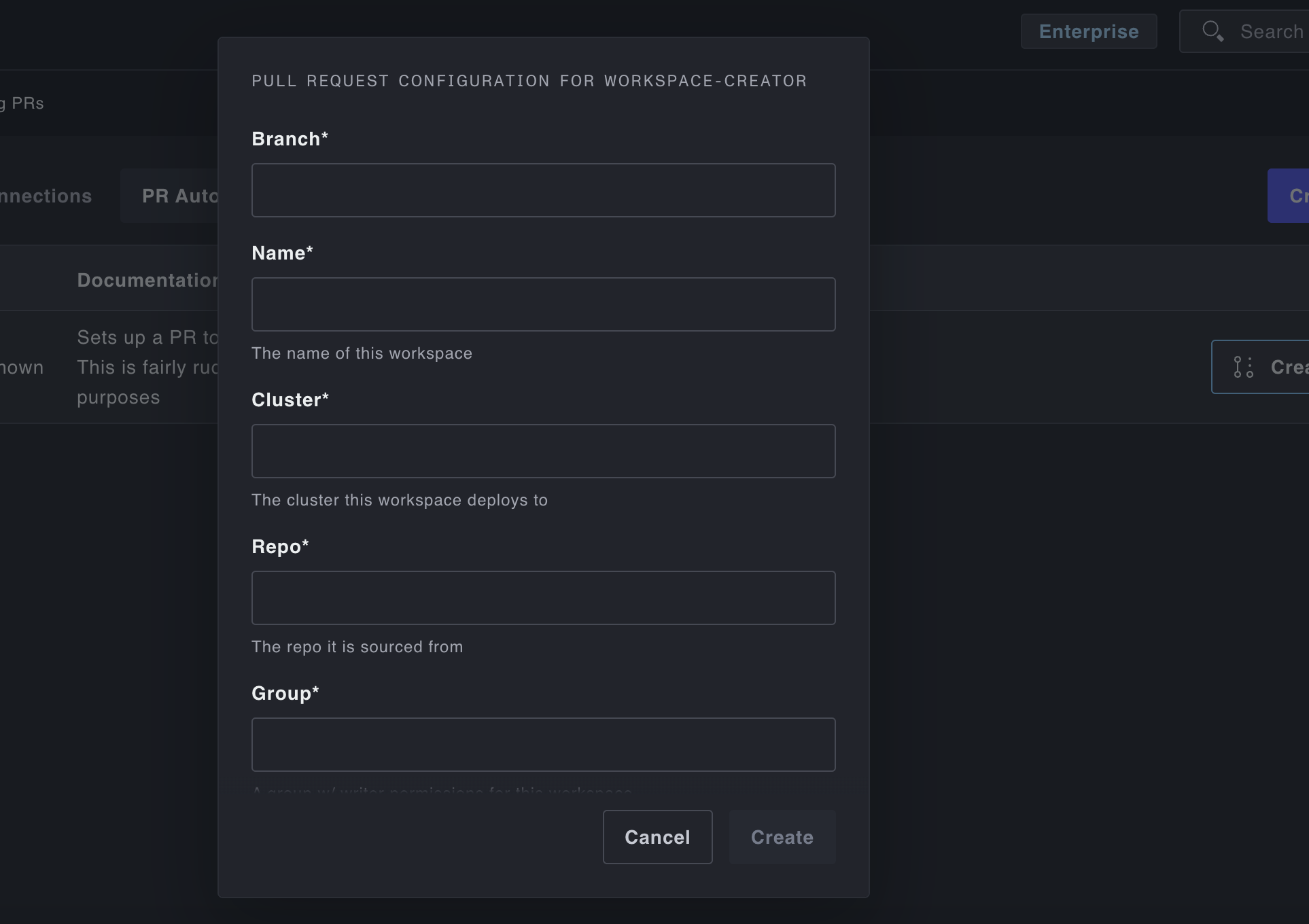PR Automation Custom Resources
Define your own Pull Request Automations with Kubernetes CRDs
You can use our CRD toolkit to generate new PR Automation flows easily. This can be as simple as generating pull requests for upgrading to a new kubernetes version in terraform, or it can involve more complex workflows. In this guide, we'll show how you can use it to provide self-service developer workspaces, a pretty common usecase for a lot of enterprises.
Defining Templates
Most of the PR automation works off of Shopify's Liquid templating engine. It's a well-documented, widely used templating library that frankly is a bit nicer than go's builtin text/template library.
For this example there are a few templates that are worth mentioning:
in templates/service.yaml.liquid:
apiVersion: deployments.plural.sh/v1alpha1
kind: ServiceDeployment
metadata:
name: {{ context.name }}
namespace: infra
spec:
namespace: {{ context.name }}
git:
folder: workspaces
ref: main
repositoryRef:
kind: GitRepository
name: infra
namespace: infra
configurationRef:
name: mottmac-pull-creds
namespace: infra
helm:
version: "0.x.x"
chart: workloads
valuesFiles:
- {{ context.name }}.yaml
repository:
namespace: infra
name: workloads
clusterRef:
kind: Cluster
name: mgmt
namespace: infraand workspace.yaml.liquid:
cluster: { { context.cluster } }
gitRepository: { { context.repo } }
access:
write:
- groupName: { { context.group } }
workloads: { { context.workloads } }The first just generates a ServiceDeployment CRD (if you aren't familiar with this, feel free to look at the docs for the Plural operator) that will ultimately create the workspace service. The second is meant to define the helm values file for that service. The variables in context will be user specifed, and you can see it also takes a list of workloads that will be the individual components spawned by that service -- the workspace is in fact an app-of-apps.
PR Automation Spec
Those templates are then used by a PR Automation resource like so:
apiVersion: deployments.plural.sh/v1alpha1
kind: ScmConnection
metadata:
name: github
spec:
name: github
type: GITHUB
---
apiVersion: deployments.plural.sh/v1alpha1
kind: PrAutomation
metadata:
name: workspace-creator
spec:
name: workspace-creator
documentation: |
Sets up a PR to provision a new workspace for a team. This is fairly rudimentary at the moment for demonstration purposes
creates:
templates:
- source: templates/service.yaml.liquid # points to the template above
destination: 'apps/workspaces/{{ context.name }}.yaml'
external: false # tells us to source the template from within the repo
- source: templates/workspace.yaml.liquid # similar as above, pointing to above templates
destination: workspaces/{{ context.name }}.yaml
external: false
scmConnectionRef:
name: github
title: 'Adding workspace {{ context.name }} for {{ context.group }}'
message: "Adding workspace {{ context.name }} for {{ context.group }}\nWorkloads to be provisioned: [{{ context.workloads }}]"
identifier: pluralsh/pr-automation-demo # id slug for the repo this automation will be applied to
configuration:
- name: name
type: STRING
documentation: The name of this workspace
- name: cluster
type: STRING
documentation: The cluster this workspace deploys to
- name: repo
type: STRING
documentation: The repo it is sourced from
- name: group
type: STRING
documentation: A group w/ writer permissions for this workspace
- name: workloads
type: STRING
documentation: comma separated list of workloadsTying this together, we've created a PR Automation that is referencing the above two yaml templates, and is configured to create new files for the results of applying each. When the automation spec is created, it will be viewable within your Plural console under the PR tab, and you'll be able to create the PR and fill out a form like:

When the automation is triggered, it will take the results of that form, pass them to the templates, print them to the configured files, and call the appropriate SCM api (Github's in this case) to generate the pull request.
In this case, if the pull request is merged, there is already another service in place to sync the apps/workspaces folder, so it would deploy as the system polls in the new CRD in that folder and the new workspace would be provisioned.